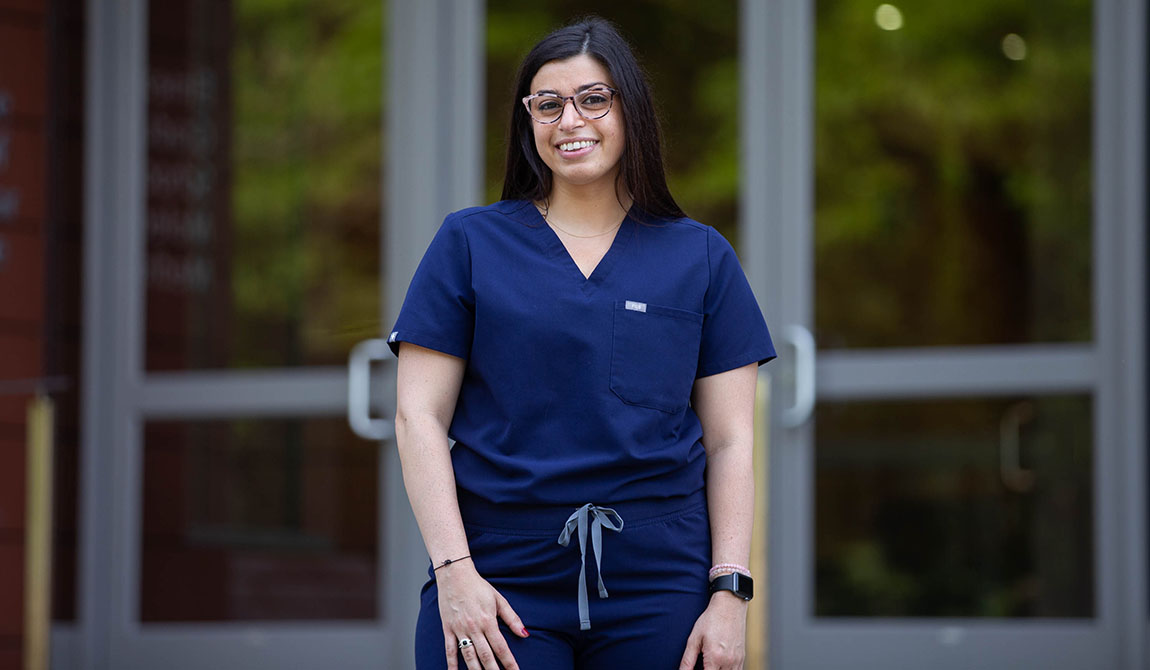Supporting the “Sickest of the Sickest”
Elisa Vicari ’08, a licensed clinical social worker in a Long Island intensive care unit, has worked to ensure families stay connected with patients despite a near-total no-visitors policy during COVID-19.By: Meghan Kita Monday, June 15, 2020 09:37 AM
 Elisa Vicari ’08 (Photo by Brooke Slezak)
Elisa Vicari ’08 (Photo by Brooke Slezak)Under normal circumstances, the families of intensive care unit (ICU) patients spend hours at their bedsides, talking to their loved ones (even if they’re unconscious), playing their favorite music and holding their hands. Families find comfort in giving this support and patients can be responsive to receiving it. Elisa Vicari ’08, a licensed clinical social worker at North Shore University Hospital in Long Island, New York, has witnessed this firsthand. Vicari acts as a guide to her ICU’s patients and their families, supporting them during the patient’s stay, helping to coordinate discharge plans in the best-case scenarios and connecting loved ones to funeral planning resources and grief support groups in the worst.
In early March, Vicari’s role became even more significant. Within a week of the first COVID-19 patient’s arrival in her ICU, all 18 beds were filled with “the sickest of the sickest COVID patients.”
“Within the blink of an eye, it seemed like the whole hospital was consumed by the virus,” says Vicari, who was a psychology major at Muhlenberg. (More than 20,000 COVID-19 patients had been admitted to the Northwell Health system, of which North Shore is a part, by early June.) “We knew we’d be hit, but I don’t think any of us understood how rapid it was going to be.”
The hospital, like many others, barred visitors, though two per patient were allowed for end-of-life situations. To help bridge the gap, Vicari posted on social media asking whether anyone had an iPad to donate—the hospital had some, but not nearly enough to facilitate videoconferencing for all the COVID-19 patients who were coming through. Within a week, she’d received 20 iPad donations for the hospital as well as $11,000 in donations to buy more.
Meanwhile, Vicari tried to fill in for loved ones in the wake of the no-visitor policy. In FaceTime sessions with families, she asked for specifics about each patient—what they liked to eat, the names of their loved ones and pets, their favorite songs. When she’d visit with the patients, she’d use specifics from those conversations (ex: “you have to get home to see Rover!”) to provide personal support. She would FaceTime families from a patient’s room and hold the patient’s hand while loved ones talked to them from the iPad.
“My patients mostly were not able to speak or interact, but it was important for their family to see them, give them love, see they’re safe and cared for and have that visual picture of where their loved one is,” she says. “I have a greater appreciation for the power of being with loved ones in critical illness situations. I watched people respond so differently when they saw their families via FaceTime.”
She also served as the contact for family members coming in for an end-of-life visit: coordinating the timing, dressing them in protective equipment and accompanying them into the room for the patient’s final moments. She would bring in the iPad so more loved ones could say their goodbyes virtually. (Vicari’s work was featured in a New York Times story about one of her patients.) Though end-of-life visits are always difficult, she says, some of these families hadn’t seen their loved one in five or six weeks. They were coming into the hospital for the first time to see their loved one for the last time. This added a layer of distress and fear not typically present in these situations.
Three months after the whirlwind began, it seems to be at least on pause—Vicari’s ICU now has no COVID-19 patients. Limitations on visitors remain in effect, as do strict personal protective equipment requirements. Still, Vicari finally feels like she has a moment to take a breather and to reflect on what just happened.
“I witnessed a lot of devastation, but also a lot of really amazing things, incredible things, illnesses people were able to come out of,” she says. “I truly believe I was able to witness some miracles.”
